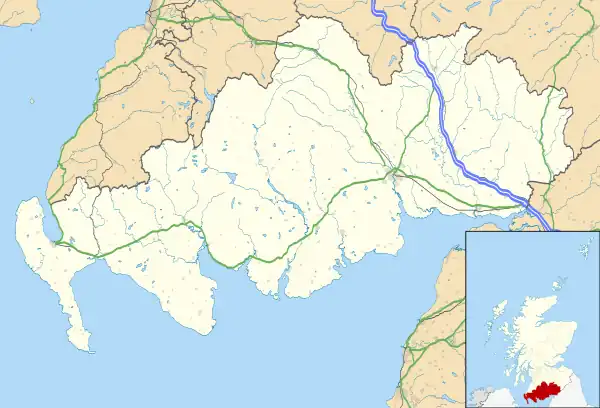Mid Gleniron
Mid Gleniron is a prehistoric site in Dumfries and Galloway used in the Neolithic and Bronze Age. The site is a scheduled ancient monument that comprises a group of six burial cairns.[1] Two of the cairns, Mid Gleniron I[2] and Mid Gleniron II[3] are chambered cairns of the Clyde tradition. These are of historic importance because of their multi-stage construction which provides evidence for the development of Clyde cairns at the beginning of the Neolithic period.[4][5][1]
| Mid Gleniron | |
|---|---|
 One of the six cairns | |
| Coordinates | 54.910121°N 4.828646°W, |
| OS grid reference | NX 18769 60932 |
| Designated | 24/10/1924 |
| Reference no. | SM1944 |
 Location of Mid Gleniron in Dumfries and Galloway | |
Mid Gleniron I & II
The chamber cairns, Mid Gleniron I & II, were excavated by Corcoran between 1963 and 1966.[6]: 29 These excavations revealed a multi-period construction. Mid Gleniron I was revealed to have been originally two separate, small (5m diameter) rectangular cairns, each with entrances into single chambers. These cairns were set in the same direction, with their cambers aligned.[7]: 105 Thomas notes the close positioning of these two cairns implies that it was anticipated that they would be incorporated into a larger construction.[5]: 10 At a later date, these cairns were modified and subsumed into a large trapezoidal cairn. A third chamber was added as well as a forecourt, typical of Clyde cairns. The facade marking out the forecourt was made of standing stones measuring over eight meters across.[7]: 105
Mid Gleniron II also apparently began as a set of two smaller cairns.[7]: 105 Like at Mid Gleniron I, this site was transformed into a large trapezoidal cairn with forecourt. However, here only one of the cairns was subsumed and altered by the new monument. The forecourt led into a new chamber which was blocked centuries later in the early Bronze Age.[7]: 111
Historic Environment Scotland's Statement of National Importance for the site notes its potentially international significance for shedding light on "the sequence and development of funerary and ritual architecture during the Neolithic and early Bronze Age."[1]
Excavation at Droughdool Mote between 1999 and 2002 revealed a round cairn at the top of the mound, similar in construction to Mid Gleniron A.[8][9]
References
- "Mid Gleniron, chambered cairns and cairns (SM1944)". portal.historicenvironment.scot. Archived from the original on 23 November 2018. Retrieved 7 August 2020.
- "Mid Gleniron | Canmore". canmore.org.uk. Archived from the original on 7 June 2020. Retrieved 7 August 2020.
- "Mid Gleniron | Canmore". canmore.org.uk. Archived from the original on 7 August 2020. Retrieved 7 August 2020.
- Stell, Geoffrey (1996). Dumfries and Galloway. Royal Commission on the Ancient and Historical Monuments of Scotland (2nd ed.). Edinburgh: The Stationery Office. p. 172. ISBN 0-11-495294-9. OCLC 36079767.
- Thomas, Julian (2015). "Context: The Prehistory of Luce Bay". In Thomas, Julian (ed.). A Neolithic Complex in Galloway: Excavations at Dunragit and Droughduil, 1999-2002. Oxford & Philadelphia: Oxbow Books. pp. 8–16. ISBN 978-1-78297-970-8.
- Corcoran, J. X. W. P. (1969). "Excavation of Two Chambered Cairns at Mid Gleniron Farm, Glenluce, Wigtownshire" (PDF). Transactions of the Dumfriesshire and Galloway Natural History and Antiquarian Society. Third Series. XLVI [46]: 29–90. Archived from the original (PDF) on 29 July 2019.
- Noble, Gordon (2006). Neolithic Scotland: Timber, Stone, Earth and Fire. Edinburgh: Edinburgh University Press. ISBN 0-7486-2698-0. OCLC 71000487.
- Thomas, Julian; Sanderson, David; Kerr, Colin (2015). "Droughduil Mote". In Thomas, Julian (ed.). A Neolithic Complex in Galloway: Excavations at Dunragit and Droughduil, 1999-2002. Oxford & Philadelphia: Oxbow Books. p. 97. ISBN 978-1-78297-970-8.
- Thomas, Julian (2015). "Discussion". In Thomas, Julian (ed.). A Neolithic Complex in Galloway: Excavations at Dunragit and Droughduil, 1999-2002. Oxford & Philadelphia: Oxbow Books. pp. 172–173. ISBN 978-1-78297-970-8.